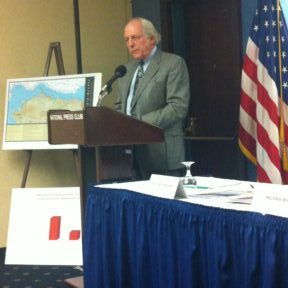
William Meadows
: Photo from Wikimedia Commons / Author of Photo: Medill DCOverview
* Served as President of the Wilderness Society from 1996 until 2012
* Was a board member of the League of Conservation Voters
* Charged that President George W. Bush “has declared war on the environment”
Tennessee native William Meadows served as President of The Wilderness Society (WS) from December 1996 to May 2012. He is currently an honorary member of the WS Governing Council.
Meadows first became interested in environmental issues as a volunteer leader in Tennessee, where he worked in conjunction with the Environmental Action Fund, the Sierra Club, and the Tennessee Environmental Council. He was a board member of the League of Conservation Voters, whose Political Committee he chaired. He was also a board member of the American Wilderness Coalition, Americans for Heritage and Recreation, the Campaign for America’s Wilderness, the Murie Center, and the National Wildlife Refuge Association. In 2002 and 2003 he served as chairman of the Green Group, a national umbrella organization of environmentalist groups.
Meadows was particularly critical of the Bush administration, which he alleges had “declared war on the environment.” “The safeguards they’re dismantling,” said Meadows, “are the results of years of open public process, involving millions and millions of people. Our message to President George W. Bush is this: Americans demand an end to the assault. Stop the rollbacks. Protect our environment.”
Demonstrating his Democratic Party loyalties, Meadows, conversely, had many positive things to say about former President Bill Clinton. At the end of Clinton’s second term, Meadows said, “From Florida to Alaska, Americans can celebrate one of the nation’s greatest environmental achievements as President Clinton and the Forest Service today protected nearly 60 million acres of the nation’s wild forests from logging and other development.” Absent from Meadows’ praise of Clinton was any mention of Clinton’s 1995 “Salvage Logging Rider” initiative which proposed to double the amount of logging on U.S. national forest land by exempting the logging industry from environmental regulatory laws.
Describing the Bush administration’s environmental policies as “the politics of pillage,” Meadows wrote in November 2004: “The Bush administration has been relentless in trying to undermine decades of progress toward protection of the national parks, national forests, and other lands that all of us inherit simply because we are citizens of this great nation. Political appointees who had spent their careers pushing the interests of the mining, logging, and oil and gas industries were handed the keys to our natural treasures. They ordered up drilling in some of the West’s most wondrous places. These ‘stewards’ went after the rule that prevents logging and road building in unprotected national forest roadless areas. They linked arms with the snowmobile industry to increase the number of snowmobiles in Yellowstone. They watered down mining standards. Now [after Bush’s 2004 re-election], the administration does not have to worry about facing the voters again. Too often, Congress has either sat by while the federal agencies have pursued this radical agenda, or has been a willing partner. Fortunately, conservation-minded Republicans and Democrats have led bipartisan efforts in the Senate that prevented President Bush from realizing his goal of turning the biological heart of the Arctic Refuge into an industrial oil complex.”
Implicit in Meadows’ statement about the Arctic Refuge is the suggestion that if oil drilling were to be permitted in that region, vast tracts of pristine Alaskan land would suddenly become covered with concrete and steel. But nothing could be further from the truth. Alaska, whose population is just slightly greater than that of Washington, DC, is about four times the size of California and contains fully 60 percent of America’s official wilderness areas. ANWR, located on the northeastern side of the state, comprises roughly 19.5 million acres, an area about the size of South Carolina. Of this, the proposed oil-drilling project would occupy only 2,000 acres, a patch of land about the size of Dulles Airport, or just over one ten-thousandth the ANWR region. If the entire state of Alaska were divided into 158,500 equal-sized parts, the proposed ANWR oil-drilling site would occupy exactly one of those parts. The U.S. Energy Department estimates that ANWR could yield more than 800 million barrels of oil per year, calling it “the largest unexplored, potentially productive onshore basin in the United States.”